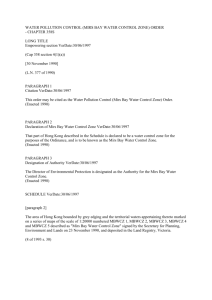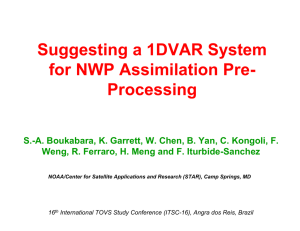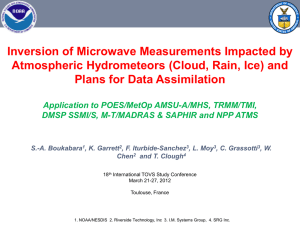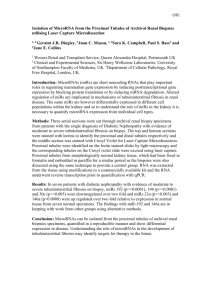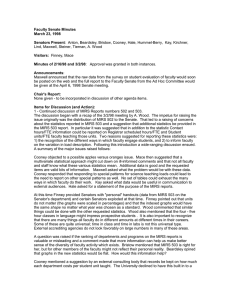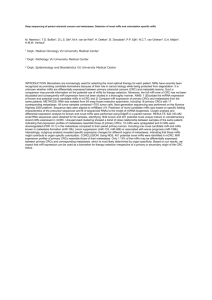Variational Inversion of Hydrometeors Using Passive Microwave Sensors
advertisement
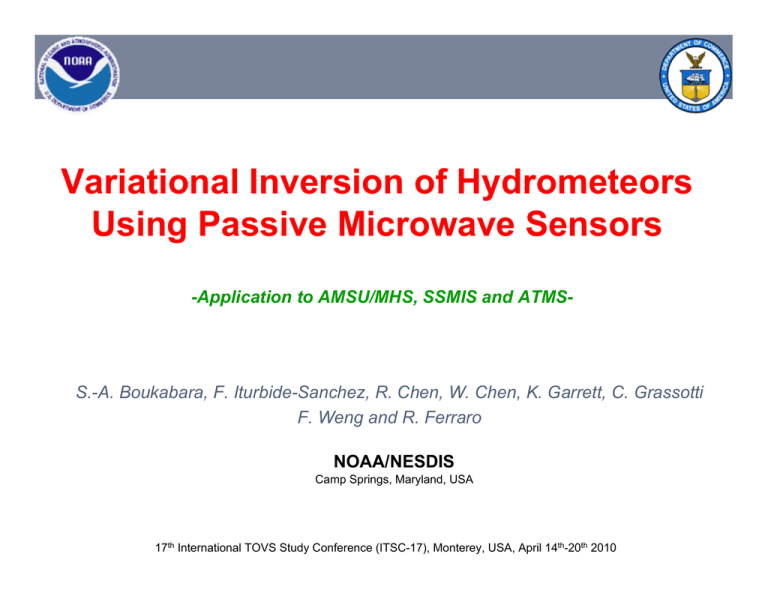
Variational Inversion of Hydrometeors Using Passive Microwave Sensors -Application to AMSU/MHS, SSMIS and ATMS- S.-A. Boukabara, F. Iturbide-Sanchez, R. Chen, W. Chen, K. Garrett, C. Grassotti F. Weng and R. Ferraro NOAA/NESDIS Camp Springs, Maryland, USA 17th International TOVS Study Conference (ITSC-17), Monterey, USA, April 14th-20th 2010 Contents 1 Overview of MiRS Algorithm 2 Concept of Cloud/Precip-clearing 3 Performance Assessment 4 Summary & Conclusion 2 1D-Variational Retrieval/Assimilation Measured Radiances MiRS Algorithm Simulated Radiances Comparison: Fit Within Noise Level ? Solution Reached No Jacobians Initial State Vector Yes Update State Vector Forward Operator (CRTM) Measurement & RTM Uncertainty Matrix E New State Vector Geophysical Mean Background Forecast Climatology Field (1D-Assimilation (Retrieval Mode) Mode) Geophysical Covariance Matrix B 3 Quality Control of MIRS Outputs 2 ϕ Convergence Metric: B K 1 E T K B K T K B B S Uncertainty matrix S: ⎛ ⎜⎜ ⎝ = − × × × + ⎞ ⎟⎟ ⎠ − × × ⎝ × 0 X × ⎛⎜⎜ ︵ ︶ − K + − X × ⎞ ⎟⎟ ⎠ Y Average kernel A: × 1 K ED T K A ⎛ ⎜⎜ ⎝ B × K T K = B D Contribution Functions D: indicate amount of noise amplification happening for each parameter. ⎞ ⎟⎟ ⎠ = × If close to zero, retrieval coming essentially from background If close to unity, retrieval coming from radiances: No artifacts from background 4 Parameters are Retrieved Simultaneously If X is the set of parameters that impact the radiances Ym, and F the Fwd Operator Necessary Condition (but not sufficient) If F(X) Does not Fit Ym within Noise X is not the solution F(X) Fits Ym within Noise levels X is a solution X is the solution All parameters are retrieved simultaneously to fit all radiances together Suggests it is not recommended to use independent algorithms for different parameters, since they don’t guarantee the fit to the radiances 5 Contents 1 Overview of MiRS Algorithm 2 Concept of Cloud/Precip-clearing 3 Performance Assessment 4 Summary & Conclusion 6 All-Weather and All-Surfaces sensor Cl ou To handle surface-sensitive channels, we add the following in the state vector: anc e gR ad i d- o ri g Ra ina ti n dia nc e gR ad ian following in the state vector: cte d • Temperature • Sensing Frequency ••Absorption and scattering properties of material Moisture To account for cloud, rain, ice, we add the • Geometry of material/wavelength interaction • Vertical Distribution • Cloud (non-precipitating) • Temperature of absorbing layers • Liquid • Pressure at which Precipitation wavelength/absorber interaction occurs • Amount of absorbent(s) • Frozen precipitation • Shape, diameter, phase, mixture of scatterers. ce Sounding Retrieval: Major Parameters for RT: Up wel li n Scattering Effect Su rf a ce o ri gi n at i ng Ra dia nce ng elli w n Dow Su rfa c e anc i d Ra e-r e fle • Skin temperature Absorption • Surface emissivity (proxy parameter for all surface parameters) Scattering Effect Instead of guessing and then removing the impact of cloud and rain and ice on TBs (very hard), MiRS approach is to account for cloud, rain and ice within its state vector. It is highly non-linear way of using cloud/rain/ice-impacted radiances. Surface 7 All-Weather: Cloud/Precip-Clearing Instead of guessing impact of cloud and rain and ice on TBs (very hard), MiRS approach is to account for cloud, rain and ice within its state vector. Advantages: It is highly non-linear way of using cloud/rain/ice-impacted radiances Does not rely on cloud or rain uniform distribution Does not rely on cloud resolving models (added uncertainty, need to linearize, speed cost, etc) Disadvantage: Results depend on assumptions made in RT (particle size, distribution, etc) Greater reliance on a robust, valid covariance matrix (flow dependent matrix becomes necessary: see poster by K. Garrett). Is the retrieval stable? Is the approach mathematically valid? Meas. Ym - EOF decomposition for all profiles(or (T,moderately Q, C, R, I) and The PDF of X is assumed Gaussian nonemissivity vector. Gaussian it is a numerical Nosince Yes iterative process) Operator Y able to Fit simulate measurements-like ∆Y=Ym-Ys Solution radiances Is the solution physically consistent? (between T, Q, C, R Errors of the model and the instrumental noise combined are and I) assumed (1) non-biased and (2) Normally distributed. -Cov Matrix constraint Forward assumed locally linear (or moderately non-Physicalmodel Retrieval & RT constraints linear) at each iteration. -Convergence (fitting Ym) Jacobians-Jacobians to determine Sim. Ys signals T Q C R I 8 Solution-Reaching: Convergence × − × ⎛⎜ ⎝ − X Y Previous version ( )⎞⎟⎠ m Y − 1 E T X Y ϕ = ⎛⎜⎝ m Y 2 Convergence is reached everywhere: all surfaces, all weather conditions including precipitating, icy conditions A radiometric solution (whole state vector) is found even when precip/ice present. With CRTM physical constraints. ( )⎞⎟⎠ Current version (non convergence when precip/ice present) 9 Contents 1 Overview of MiRS Algorithm 2 Concept of Cloud/Precip-clearing 3 Performance Assessment 4 Summary & Conclusion 10 Hydrometeors Inversion Approach MIRS Core Products (from 1DVAR) CLW, IWP and RWP Sensor-independent Function which allows expanding to all sensors easily (pending 1DVAR core products) Hydrometeors are hard to validate. RR is easier to MIRS Rainfall Rate Algorithm assess (wrt ground-based radar, gauges). Assessing RR + a2RWP + a3IWP RR = a1CLW is an indirect validation of IWP, CLW, RWP. MIRS Rainfall Rate (mm/hr) 11 Rainfall Rate Assessment MiRS Monthly composite (Metop-A) MSPPS Monthly composite (Metop-A) 1DVAR Heritage algorithm: based on physical regression Significant reduction in Rain false alarm using MiRS, at surface transitions and edges 12 MiRS RR part of IPWG Intercomparison (N. America, S. America and Australia sites) No discontinuity at coasts (MiRS applies to both land and ocean) This is an independent assessment where comparisons of MiRS RR composites are made against radar and gauges data. Image taken taken from from IPWG IPWG web web site: site: credit credit to to John DanielJanowiak Villa 13 Image MiRS RR Comparison to Gauges & Radar Upper Limit set by the Rain Gauge to Rain Radar Comparison 14 Qualitative check of the Cloudy/Rainy radiance handling Cross-sectionsMiRS of both TRMM and MiRS products at 25 degrees North Rain Water Path TRMMcase Rain/Ice Profiles A test comparison with TRMM rain/iceNotes: product was conducted on 2010/02/02 Ice bottom -The rain events were not captured exactly-Generally, at the sameconsistent time (shiftfeatures noticed) and MiRS (except for -A qualitative assessment was Rain done vertical TRMM cross-section top on thebetween -MiRS produces T(p), Q(p), cloud, rain and expected ice profileshift) -Purpose is to check if these products behave Vertical Cross section physically MiRS Rain/Ice Profiles - Ice is found on top of liquid rain Freezing level MiRS Moisture -Transition between frozen and liquid is delineated by the freezing level determined from the temperature Vertical Cross section profile. -Moisture increases in and around the rain event MiRS Temperature TRMM (2A12) Rain Rate - Suggests that these products are reasonably constrained within physical inversion 15 Contents 1 Overview of MiRS Algorithm 2 Concept of Cloud/Precip-clearing 3 Performance Assessment 4 Summary & Conclusion 16 Summary & Conclusion MiRS is a generic retrieval/assimilation system (N18, N19, Metop-A, DMSP F16/18 SSMIS). Being extended to NPP/ATMS, TRMM/TMI and GPM/Mega-Tropiques All parameters impacting TBs are retrieved simultaneously: sounding, emissivity, skin temperature, cloud, rain, ice, allowing point-to-point variation of emissivity over land Final solution fits measurements (a necessary requirement). Inclusion of hydrometeors in retrieval allows processing cloud/rain –impacted radiances. Non-linear cloud-precip clearing. Physical Constraints are included through Covariance. Assessment of hydrometeors performed using RR as proxy. Results show that MiRS RR is consistent with established algorithms perfs, with the added value of a physically 17 consistent solution. BACKUP SECTION 18 X ( Y Y ) E T X ) m 0 x x K 0 x y x y ︵ ︶︵ ︶ ∂ = To find the optimal solution, solve for: ∂ = ⎡ ⎤ ︵ ︶ ︵ ︶ = + − ⎢ ⎥ Assuming Linearity ⎣⎢ This leads to iterative solution: ︶ ⎞⎟ + ⎠ n X Δ n K −︵ ︶ ⎞⎟ + ⎤ ⎥ ⎦ ⎠ n X Δ n K ⎫ ⎪⎡⎛ ⎬⎢⎜ ⎪⎣⎝ ⎭ −︵ n X − Y + ⎞ ⎟⎟ ⎠ m Y ⎛ ⎜⎜ ⎝ − ⎫ ⎪⎪⎡⎛ ⎬⎢⎜ ⎪⎣⎝ ⎪⎭ ⎦⎥ n X − − 1 E More efficient (1 inversion) − + ⎞ ⎟ ⎟ ⎠ Tn K B n K Tn K B 1 n X Δ + ⎧ = ⎪⎨ ⎪ ⎩ Y m Y 1 E T n 1K n K 1 E T n K 1 B 1 n X Δ + = ⎧ ⎪⎪⎛ ⎨⎜⎜ ⎪⎝ ⎪⎩ 0 X X J X ' J ⎤ Jacobians & Radiance −︵ ︶ × − × Simulation −︵ ︶⎥ from Forward Operator: CRTM⎦ 1 ⎦ ⎣ ( Y )⎤⎥ + ⎡⎢ ×( − m − Y 1 2 × X0 X ) 1 − B ( T X J ︵ ︶= ⎡ ⎢⎣ X0 X 1 2 Cost Function Minimization Cost Function to Minimize: ⎤ ⎥⎦ Preferred when nChan << nParams (MW) 19 Importance of the Covariance Matrix TPW Horizontal Field ECMWF WV cross-section 21Rainy Deg atmospheric profiles only, Covariances using rather than a Global climatology, had a significant impact on performances. In the cases examined, the use of a covariance matrix specific to precipitating conditions MiRSsignal WV Cross-section helps to overcome the loss of radiometric in the Climatology Background MiRS physical retrieval. MiRS Rain Profile Cross-Section MiRS WV Cross-section Rain-Specific Background 20 MiRS General Overview VerticalRadiances Integration and Post-Processing TPW RWP IWP CLW Temp. Profile 1DVAR Outputs Rapid Algorithms (Regression) Humidity Profile Advanced 1st Guess Retrieval Liq. Amount(1DVAR) Prof Vertical Vertical Integration & Integration Post-processing Ice. Amount Prof selection Rain Amount Prof Emissivity Spectrum MIRS Products Skin Temperature Core Products Post Processing (Algorithms) -Sea Ice Concentration -Snow Water Equivalent -Snow Pack Properties -Land Moisture/Wetness -Rain Rate -Snow Fall Rate -Wind Speed/Vector -Cloud Top -Cloud Thickness -Cloud phase 21 All-surfaces: Variational Handling of Surface-Sensitive Channels Similar to handling cloud and hydrometeors, MiRS approach to account for surface-sensitivity of channels is by accounting for emissivity vector within state vector. Advantages: Extend retrieval to all surfaces (only difference is background covariance and mean used). Example: TPW over land. Generating an emissivity vector product, clear from atmospheric effects (used for a more accurate estimate of surface parameters) Consistent treatment of all parameters globally (same methodology). Example: RR is retrieved over ocean and land using the same code. Greater physical distinction between Tskin and Emissivity (based on physical Jacobians and different spectral signatures) Allows a point to point variation of emissivity (useful for coasts, after rain, etc) Disadvantages: Great emphasis must be given to the balance between different parameters (so that emissivity does not become a sink hole for variability due to other parameters such as cloud: hard) Great constraint is put on the accuracy of emissivity 22 Assumptions Made in Solution Derivation The PDF of X is assumed Gaussian Operator Y able to simulate measurements-like radiances Errors of the model and the instrumental noise combined are assumed (1) non-biased and (2) Normally distributed. Forward model assumed locally linear at each iteration. 23 Retrieval in Reduced Space (EOF Decomposition) All retrieval is done in EOF space, which allows: Retrieval of profiles (T,Q, RR, etc): using a limited number of EOFs More stable inversion: smaller matrix but also quasi-diagonal Time saving: smaller matrix to invert Mathematical Basis: EOF decomposition (or Eigenvalue Decomposition) • By projecting back and forth Cov Matrx, Jacobians and X L B T L Θ = × × Diagonal Matrix Transf. Matrx Covariance matrix (used in reduced space retrieval) (computed offline) (geophysical space) 24 & (2) No risk of having unphysical negative values Advantages: (1) Distributions made more Gaussian Retrieval in Logarithm Space P=416 mb P=506 mb P=606 mb P=718 mb P=810 mb P=915 mb P=506 mb P=606 mb P=718 mb P=810 mb x J × x x g o L ∂ ∂ = ∂ ∂ ︵ ︶ P=915 mb Rx = x R g o L Jl Applied to WV, Cloud and precip P=416 mb ∂ = × ∂ ︵ ︶ 25 Challenges of Profiling in Active Areas • Case of July 8th 2005 700 mb DeltaT=3K MHS footprint size at nadir is 15 Kms. But at this angles range (around 28o), the were MHS 4 Dropsondes footprint is around 30 Kms All these dropped within 45 minutes and are located within 10 kms from each other 700 mb Zoom in space (over the Hurricane Eye) and Time (within 2 hours) Temperature [K] DeltaQ=4g/Kg Water Vapor [g/Kg] 26 TPW Global Coverage MiRS GDAS MiRS TPW Retrieval (zoom over CONUS) Very similar features to GDAS Smooth transition over coasts 27 No Discontinuities at Coast 28
